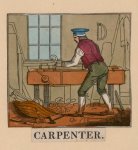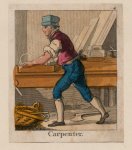So first, this is late and is actually December's Tool of the Month (sorry), and second, this is really two tools, but there's a connection so I'm breaking my own rule (not sorry).
Here's the deal, I was frantically trying to get Clara's play kitchen finished in time for Christmas (that's another post...) and worked myself into a bit of a corner (so to speak). I was ready to install the bottom, which was going to be screwed down to cleats on the sides, but I needed to drill pilot holes to keep the cleat from splitting. On one side that was not a problem, but on the other the cleat for the bottom of the oven was just a few inches above the bottom cleat, and there was not much room to work. My hand drill was out, and even my
cobbler's awl couldn't fit in there. Hmm.
I was just resigning myself to removing the upper cleat, which I really didn't want to mess with as it was glued in the middle (but not the ends to allow the sides to move) and I was not looking forward to dealing with that. Then, inspiration struck and less than two minutes later the holes were bored - sweet!
Here's the setup for tool #1:
The awl is a finish nail sharpened on a file and I think you can see what the handle is. It worked well with one hand applying pressure up near the awl, and the other working the handle back and forth.
I love it when a problem can be solved by improvising with what's on hand!
So after solving that problem, I faced the second problem of driving screws in the same location. This one was solved by drawing on my deep reserve of tools. As you've probably noticed, I love old tools and will frequently acquire tools that I don't technically "need" but know will come in handy someday. This was one of those days.
The tool is a Mayhew 18" auger bit extension. I'm not sure, but I think this may be the same Mayhew Tools that is still around today. They started back in 1856 in Shelburne Falls, Massachusetts. If I had to guess the age, I say this was from the early 20th century - somewhere around the 1920's. But that's only a guess, and of course, I could be wrong.
What I really like about this extension is the very simple locking mechanism it uses. Basically, there is an inner cylinder with a tapered socket for the auger's square-tapered tang. That's the inner square you can see in the image below. The outer cylinder has a larger square opening rotated 45 degrees to the inner square. This outer square opening is larger than the tapered tang of the bit, but will lock down across the shoulders of the tang due to its rotation. In use, the outer cylinder is raised by means of a threaded collar, the bit tang inserted through the outer square, rotated, then dropped into the inner socket. All that remains is to screw the outer cylinder down until the bit is locked in tight. Very simple, and much easier to do than explain.
Here's the extension with both squares visible - the Lee Valley brace hex driver adapter I use is on the bench in the background:
Here's a shot of the adapter locked in the extension with a square drive bit fitted in the adapter:
And finally, the point of using this extension - it allowed me to use a much shallower angle of approach on the screw by moving the brace further away from the cramped location:
Here's a closer shot which should make it pretty clear:
With the brace set to ratchet, I had no problem driving the screws home.
I love it when a problem can be solved by having just the right tool when you need it!
This was a pretty cool evening in the shop - hitting two of the things I love about woodworking, improvising tools and techniques and getting to use a special old tool, all in the space of about five minutes! A good evening indeed.




































